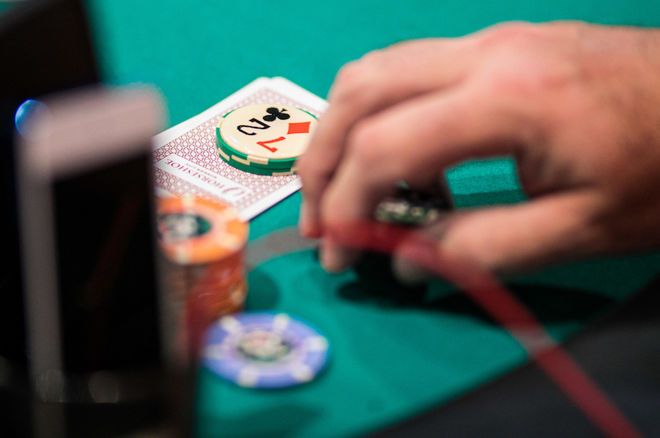Poker Blind Definition
How to Set Up a Poker Blinds Schedule A typical T1000 blinds schedule for a No-limit Texas Hold'em poker tournament is shown to the right. T1000 means that each player is issued 1000 chips at the start of the tourney. This blinds schedule starts out slow for the first hour and should result in a poker tournament of about 4 hours.
Blind- Definition of Dead Blind in the poker dictionary. In a cash game, if a player leaves and misses the blinds, they must post one set of blinds once they return to the table.
- Poker/Blind stud synonyms, Poker/Blind stud pronunciation, Poker/Blind stud translation, English dictionary definition of Poker/Blind stud. Poker in which the first round of cards, and often the last, is dealt face down and the others face up when five cards per hand are dealt.
A blind is a forced bet that is placed before the cards are dealt. It is used to seed the pot in flop and draw games. Generally, flop and draw games will use a nominal dealer button to indicate last action after the flop or draw. This button is moved in a clockwise manner, one position to the left, before the start of each hand, in order to give each player equal time from each betting position. Most games will have two blinds, a small blind to the left of the button, and a big blind to the left of the small blind. Some games will have a third blind which is commonly placed on the button. Blinds are called “big” or “small” based upon their relative size and not upon what position they are posted from, although it is standard to post the big blind to the left of the small blind. Typically, the big blind will be a full sized bet of the lower betting limit, and a small blind will be a portion of the lower betting limit. For example, a $3/$6 Hold’em game might have a $3 big blind and a $1 small blind.
Every player is required to post their blinds when it is their turn to do so. If they do not, they will be given a missed blind button and will be dealt out. If this happens, the player must wait until it is their turn to take the big blind again, or post all owed blinds at once on the subsequent hand, if they do not wish to wait.
If a player takes their blind in turn, the amount posted will be credited towards a call or raise. This type of blind is called a “live blind.” If a player is making up owed blinds, only the amount of the big blind is live. The small blind (and any other blinds owed if more than two blinds are being used) is dead and therefore will not be credited towards a call or raise. This type of blind is called a “dead” blind. For example, a $3/$6 Hold’em game has a Big Blind of $3 and a small blind of $1. If both players have posted their blinds in turn, and the pot has been raised to $6, the big blind would owe $3 to call and the small blind would owe $5 to call. If a third player has made up his blinds by posting $4 ($3 big blind plus $1 dead small blind), he would have to call an additional $3 with $1 dead and remaining in the pot.
Usage: Live Blind, Dead Blind, Big Blind, Small Blind, Post Both Blinds, Blind On The Button
Poker Blind Definition Synonym
Previous Poker Term: Blank

Next Poker Term: Blind Off
Mark Poker Articles, Poker Rules
This article is a part of the Poker Rules series.
Step 3: The Texas Hold’em No Limit Gameplay:
In my previous post in this series I described the different Texas Hold’em hands and how they rank against each other. We are now ready to move on to the actual Texas Hold’em game and how it’s played. In Texas Hold’em two players – the Big Blind and the Small Blind – are required to place bets (known as blinds) in the pot (the amount of money to be won in any single completed hand) before any cards are dealt. This means that in Texas Hold’em there will always be money to win in a hand. The dealer button rotates clockwise after each completed hand, and is used to represent the player holding the dealer position. The position of the dealer button also determines the position of the Big and Small Blind as the Small Blind is the player to the immediate left of the dealer and the Big Blind is the player to the left of the Small Blind (see the figure below). In online poker you don’t have to worry about the position of the dealer and Big and Small Blinds since this is all taken care of automatically by the poker software.
A Texas Hold’em hand begins with the dealer dealing one card face down in a clockwise manner to all the players at the table starting with the player to the immediate left of the Big Blind. Then the dealer deals one more card to each player in the same way.
When all players have two face down cards (known as hole or pocket cards) the first betting round (also known as the preflop betting round) begins, starting with the player to the immediate left of the Big Blind and continuing clockwise around the table. In No Limit Hold’Em the smallest possible bet is the same size as the Big Blind; there is no upper limit to bets. When it’s your turn to bet and you are not the Big Blind you have 3 options: Call, Raise or Fold.
- By calling you bet the same amount as the biggest bet made by the players acting before you.
- By raising you call the biggest bet made by the players acting before you and then place an additional bet over the top.
- By folding you choose not to continue playing your pocket cards, and you will be out of the game until the next hand starts.
When you are the Big Blind in the first betting round and nobody has made a bet larger than you big blind you can choose to Check, Raise or Fold. By checking you simply pass on the turn to the next player without making any bet. This is possible since you have already paid the Big Blind into the pot.
When the big blind has completed his/hers turn, the first three community cards – known as the flop- are dealt face up in the middle of the table. The second betting round then starts with the first player to the left of the dealer who is still playing the hand and continues clockwise. The second betting round ends with the dealer.
The next and 4th community card – known as the turn or the 4th street – is dealt face up and a third betting round follows in the same manner as the second betting round.
Finally the 5th and last community card – known as the river or the 5th street – is dealt face up and a fourth betting round follows in the same manner as the second and third betting rounds. If a player bets during the fourth betting round and all the other players remaining fold then he or she wins the pot without having to show his/hers pocket cards. If one or more players call then a showdown, where all remaining players reveal their pocket cards, determines the winner of the pot according to the hand ranking scheme I described earlier. So there you have it, the Texas Hold’em No Limit gameplay in all its simplicity. There are a couple of extra subtle details regarding special circumstances that may occur during the game, but I will go more into detail with these later.
My next post in this series will deal with choosing which starting hands to play depending on which position you are in relative to the dealer button.

This post belong to the following series:
You could be posting your articles on the Poker Bankroll Blog. Read all about it here.
Similar Posts:
Leave a comment
Special promotions
Poker Pro Bankroll Series
Latest Poker Strategy Articles
